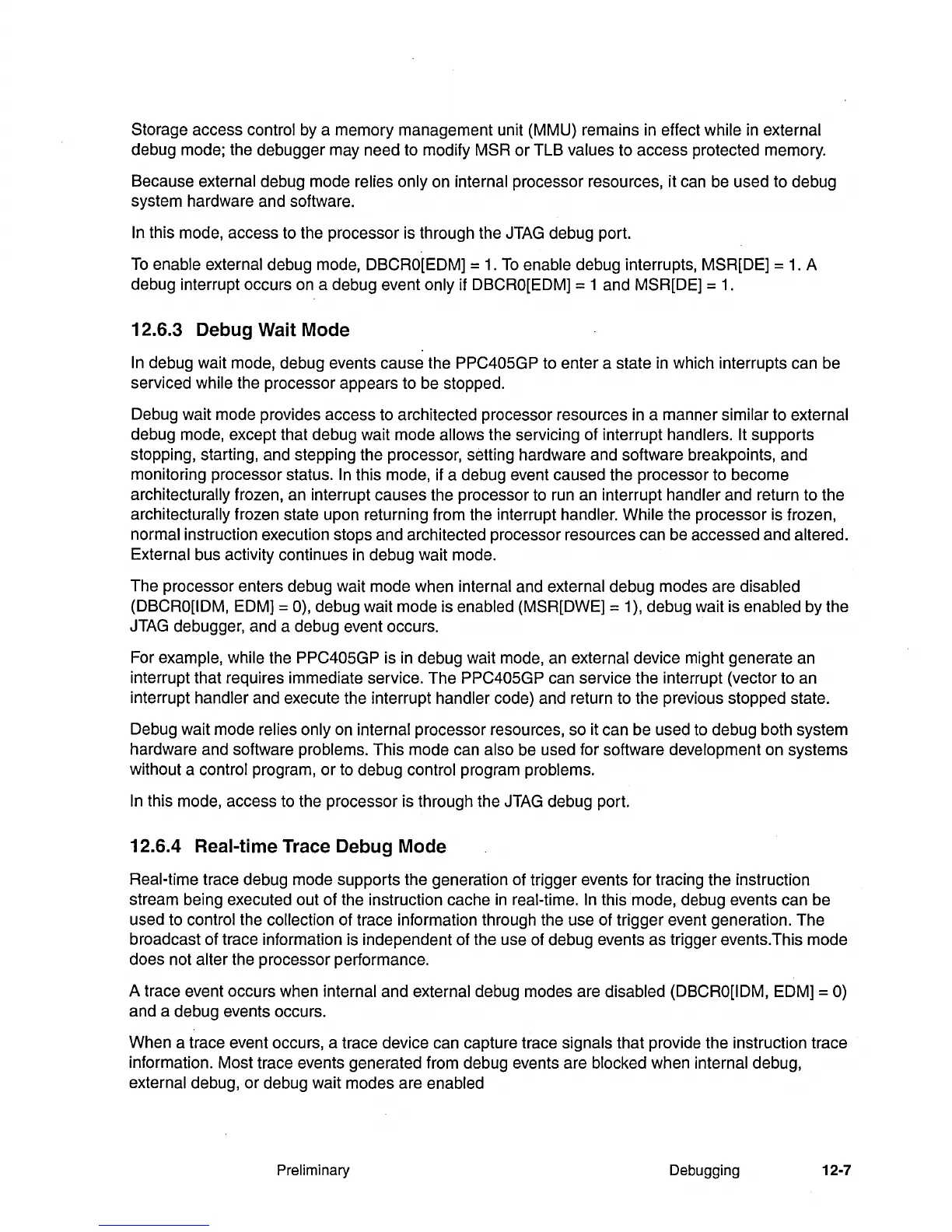Storage access control by a memory management unit (MMU) remains
in
effect while
in
external
debug mode; the debugger may need to modify
MSR
or
TLB values to access protected memory.
Because external debug mode
relies only on internal processor resources, it can be used to debug
system hardware and software.
In this mode, access to the processor is through the JTAG debug port.
To
enable external debug mode, DBCRO[EDM] =
1.
To
enable debug interrupts, MSR[DE] =
1.
A
debug interrupt occurs on a debug event
only if DBCRO[EDM] = 1 and MSR[DE] =
1.
12.6.3 Debug Wait Mode
In debug wait mode, debug events cause the PPC405GP to enter a state
in
which interrupts can be
serviced
while the processor appears to be stopped.
Debug wait mode provides access to architected processor resources
in
a manner similar to external
debug mode, except that debug wait mode
allows the servicing of interrupt handlers. It supports
stopping, starting, and stepping the processor, setting hardware and software breakpoints, and
monitoring processor status.
In
this mode, if a debug event caused the processor to become
architecturally frozen, an interrupt causes the processor
to
run an interrupt handler and return to the
architecturally frozen state upon returning from the interrupt handler.
While the processor is frozen,
normal instruction execution stops and architected processor resources can be accessed and altered.
External bus activity continues
in
debug wait mode.
The processor enters debug wait mode when internal and external debug modes are disabled
(DBCRO[IDM, EDM] = 0), debug wait mode is enabled (MSR[DWE] = 1), debug wait is enabled by the
JTAG debugger, and a debug event occurs.
For example,
while the PPC405GP is
in
debug wait mode, an external device might generate an
interrupt that requires immediate service. The
PPC405GP can service the interrupt (vector to an
interrupt handler and execute the interrupt handler code) and return to the previous stopped state.
Debug wait mode
relies only on internal processor resources, so it can be used
to
debug both system
hardware and software problems. This mode can
also be used for software development on systems
without a control program,
or
to debug control program problems.
In
this mode, access to the processor is through the JTAG debug port.
12.6.4 Real-time Trace Debug Mode
Real-time trace debug mode supports the generation of trigger events for tracing the instruction
stream being executed out of the instruction cache
in
real-time. In this mode, debug events can be
used to control the
collection of trace information through the use of trigger event generation. The
broadcast of trace information is independent of the use of debug events as trigger events.This mode
does not
alter the processor performance.
A trace event occurs when internal and external debug modes are disabled
(DBCRO[IDM, EDM] = 0)
and a debug events occurs.
When a trace event occurs, a trace device can capture trace signals that provide the instruction trace
information. Most trace events generated from debug events are blocked when internal debug,
external debug, or debug wait modes are enabled
Preliminary
Debugging
12-7

